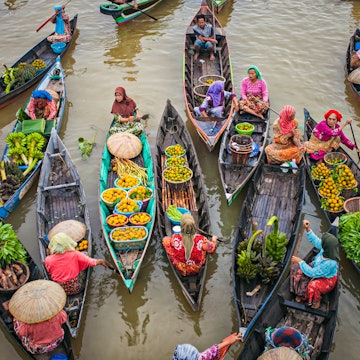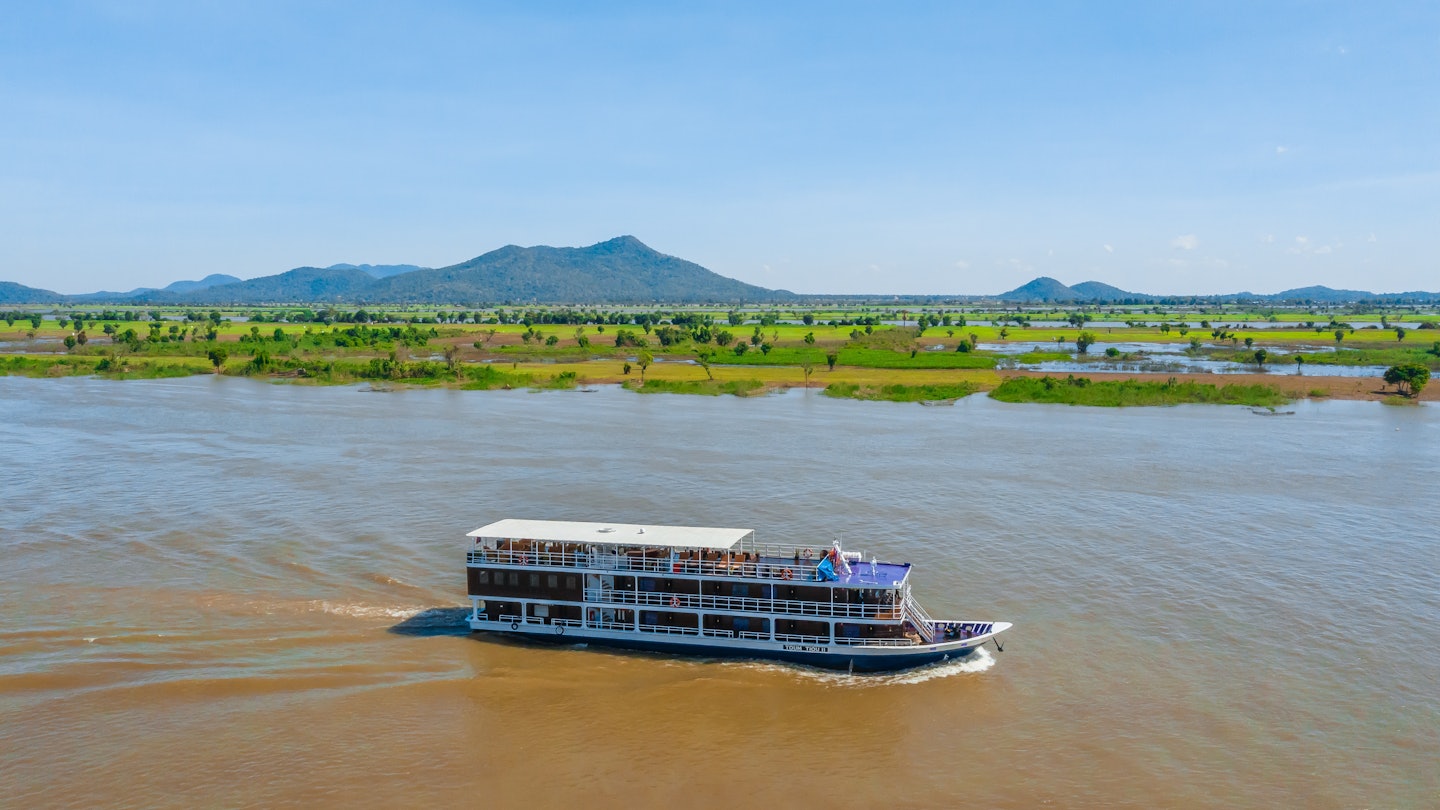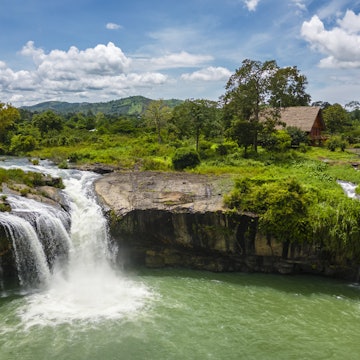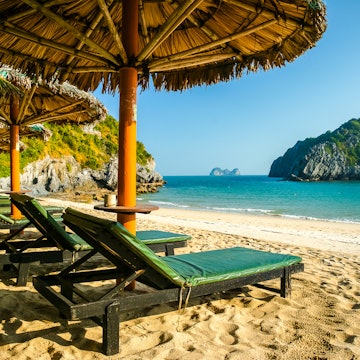

Toum Tiou II sailing along the Mekong. CF Mekong
Bordered by Cambodia to the north, the Gulf of Thailand to the west, and the East Sea (South China Sea) to the east and south, the Mekong Delta is a lush region in southern Vietnam and Cambodia where the Mekong River splits into a network of nine branches before emptying out to the sea. Known as Dong Bang song Cuu Long in Vietnamese (“the Nine Dragons Delta”) and Khmer Krom (“Lower Cambodia”) in Khmer, the region is largely agricultural, an idyllic postcard of what visitors imagine the Vietnamese and Cambodian countryside to look like: farmers in conical hats working the land, grazing water buffalo, children playing in the river, and villagers making products out of locally-found materials, like water hyacinth, palm fronds and coconut.
Home to up to 9000km of rivers and canals, there’s no better way to experience the Mekong Delta than on a cruise, where you can watch pastoral life play out along the river banks, sample the amazing bounty of “the rice bowl” of Vietnam, and interact with the people of the area, all while leaving the cooking and activities planning to someone else.
Having lived in the region for more than two decades, I never turn down an opportunity to spend time in the Delta, a place where the rhythm of life seems to slow right down, marked by the rise and fall of the river and the cycles of planting and harvesting rather than the dates on a calendar. Here’s all you need to know to plan a cruise through the Mekong Delta.

Should I do a day trip or an overnight cruise?
The start of the Delta is a 2–3 hour bus ride from Ho Chi Minh City to My Tho or Ben Tre, making it a tempting day trip option. After arriving, you’ll typically hop aboard a small sampan or row boat and cruise through the mangroves for 15–20 minutes. Stops might include orchards to sample tropical fruit, honey and snacks made from rice or coconut, and workshops to see how products like rice paper and coconut candy are made. You’ll also walk past markets and pagodas with running commentary from your guides and perhaps even take a short cycling trip along country paths before boarding the bus for the return trip. For those who are short on time, day trips provide a glimpse into life in the Delta, but the long hours of driving will likely leave you exhausted. If at all possible, a multiday cruise is much more preferable with balanced periods of exploration and relaxation.
From Phnom Penh, boats are available for charter for short trips down the river, usually with a stop at nearby Silk Island, making a day trip more palatable.

When is the best time to cruise the Mekong Delta?
Day trips are available year-round while the cruise season primarily runs during the dry season, from November to April, when pleasant temperatures, clear skies, and minimal rainfall make cruising a joy. Some cruises will still operate during the wet season from May to October when larger boats are able to navigate waterways easily thanks to the high water. If traveling to or from Siem Reap during the peak dry season (typically from late February to early June), ask your cruise line whether they will be able to sail on the Tonlé Sap Lake or if that leg of the journey will be made via a 5–6 hour coach ride instead.
Which itinerary should I choose?
Within Vietnam, most multiday cruises arrive/depart from My Tho, about 70km southwest of Ho Chi Minh City with fewer companies using Can Tho (160km) as a hub, sailing on a less-visited arm of the Mekong River. A few, such as CF Mekong Cruises, whose ships have low air draft, are able to navigate smaller canals and duck under bridges, allowing them to dock conveniently right in Ho Chi Minh City.
Cruises within Vietnam only operate round trips (from Ho Chi Minh City, My Tho or Can Tho) or end up in Rach Gia, with onward ferry service to the island of Phu Quoc in the Gulf of Thailand.
Transnational cruises operate between Ho Chi Minh City and Phnom Penh on 3- and 4-day itineraries with longer 8- or 9-day cruises sailing between Ho Chi Minh City and Siem Reap, the gateway to the fabulous ruins of Angkor.

What should I look for in a cruise line?
The beauty of a Mekong Delta cruise is in experiences that still feel authentic and untouched by mass tourism. The further you get away from the big urban centers of Ho Chi Minh City and Phnom Penh (and away from the day trippers), there’s more chance of this happening.
You’ll want to start by reviewing the cruise itinerary. How many days are spent in big cities versus small ports? Is there a variety in shore excursions, both in location (temples, markets, craft villages, etc) as well as transportation mode (walking, cycling, tuk-tuk, etc)? Do the onboard activities sound appealing?
Other than the itinerary, you’ll want to check out the ship and its amenities. Ships range from the very basic to the opulent, complete with onboard hot tub, spa and library along with offering lectures, workshops and entertainment, usually in the form of local musicians and other performers who come on board for the evening. Take a look at the deck plans to envision how you’ll spend your time aboard. Larger ships often appeal to tour groups, leading to more socializing with fellow passengers.
If your cabin doesn’t have a balcony, you’ll want to look at images of the public spaces, including the restaurant and the lounge or sun deck to see if they’re inviting areas where you’ll want to spend time. In addition, research crew-to-passenger ratio and read reviews on shore excursions, customer service, and cuisine to help shape your expectations.
Reviews can also reveal the intangibles that won’t be found in brochures. For instance, on my cruise aboard the Toum Tiou II, the staff thoughtfully arranged for a local police officer to escort us on a bike ride through a busy part of town, and the mealtimes were a highlight, showcasing local ingredients and flavors like pomelo (a citrus fruit that’s similar to grapefruit) and Khmer-style curries. Since you’ll be spending a lot of time with your guide (typically a Vietnamese guide on the Vietnam side and a Khmer guide for the Cambodian side), you’ll want to read reviews that touch on English-speaking ability, as this can vary widely and significantly impact your enjoyment of the cruise.

What are some experiences to expect on a Mekong Delta cruise?
The Mekong Delta represents a wonderful mix of culture, nature, history and cuisine. Compare shore excursion descriptions between companies to see which really get off the beaten path. One of my favorite experiences was a visit to an out-of-the-way Khmer pagoda where the group had a chance to sit down with the head monk for an extended discussion about temple life and Buddhist beliefs with the help of an interpreter. Sitting amidst artfully faded murals and being able to ask anything felt like a pinch-me moment.
We also visited a home in the countryside where a man showed us how he climbed sugar palm trees to collect sap to make jaggery while his neighbor fashioned simple pots out of clay.
On the Vietnam side, an excursion to the Tra Su Forest was nothing short of magical, as our canoes soundlessly glided over thick carpets of water plants with storks and bats for company.

What should I pack for a Mekong Delta cruise?
Other than perhaps a light rain poncho (although single-use ones are available everywhere for less than US$1) and some mosquito repellent, you really don’t need to pack anything special for a Mekong Delta cruise. Embrace the fact that you’ve paid for a floating hotel with most things included, along with crew who will bend over backwards to make your trip seamlessly delightful.
Top tips for a worry-free Mekong Delta cruise
Buy a SIM card. The wi-fi on ships is notoriously spotty, especially when away from urban centers. The signal may not be strong enough to reach all areas, so having your own data plan is recommended.
Carry small amounts of cash in case you want to pick up souvenirs or perhaps a snack or refreshment when on shore excursions.
Bring medication for headaches, allergies and stomach issues as you may be a day away from a pharmacy at some points.
While waiting to book may lead to last-minute discounts, it’s usually best to reserve early so that you can plan other travel pre- and post-cruise.
In some cases, rates can be negotiated directly with the cruise line, especially when it comes to group travel or asking if a solo supplement can be waived or reduced.
Alcoholic drinks are typically pricey aboard cruises. Ask what the ship’s policy is on bringing alcohol on board with a corkage fee.
James Pham traveled to the Mekong Delta on the invitation of CF Mekong Cruises. Lonely Planet does not accept freebies in exchange for positive coverage.
















